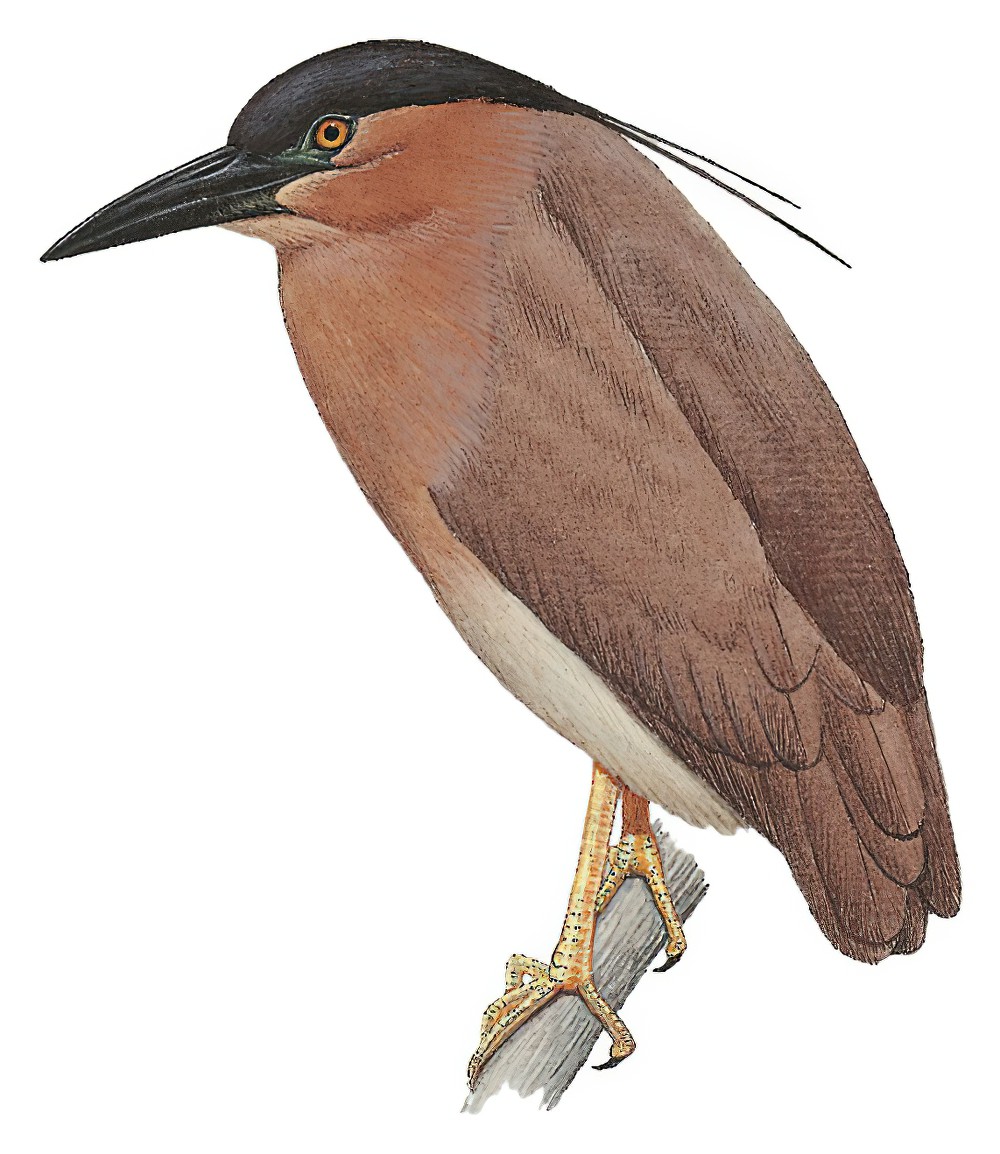Rufous Night-Heron / Nycticorax caledonicus

Rufous Night-Heron
SCI Name:
Protonym: Ardea caledonica Syst.Nat. 1 pt2 p.626
Taxonomy: Pelecaniformes / Ardeidae / Nycticorax
Taxonomy Code: runher1
Type Locality: New Caledonia.
Author: Gmelin, JF
Publish Year: 1789
IUCN Status: Least Concern
DEFINITIONS
NYCTICORAX
(Ardeidae; Ϯ Black-crowned Night Heron N. nycticorax) Specific name Ardea nycticorax Linnaeus, 1758; "153. NYCTICORAX INFAVSTVS. THE NIGHT RAVEN." (T. Forster 1817); "Nycticorax T. Forster, Synopt. Cat. Brit. Bds., 1817, p. 59. Type, by tautonymy and monotypy, Nycticorax infaustus Forster = Ardea nycticorax Linné." (Peters 1931, I, 114) (see nycticorax).
Var. Nicticorax, Nigricorax (L. niger black).
Synon. Maridus, Megaphoyx, Nycterodius, Nyctiardea, Scotaeus.
nycticorax
L. nycticorax, nycticoracis unknown bird, probably an owl < Gr. νυκτικοραξ nuktikorax, νυκτικορακος nuktikorakos bird of evil omen mentioned by Aristotle, Hesychius and other authors, probably a sort of owl, but long associated with the night heron < νυξ nux, νυκτος nuktos night; κοραξ korax, κορακος korakos raven < κρωζω krōzō to croak; “The Germans call it, Nacht rab, that is, Night-raven, and under that title it is figured and described by Gesner ... It is called Night-Raven, because in the night time it cries with an uncouth voice, like one that were straining to vomit” (Ray 1678); "76. ARDEA. ... Nycticorax. 9. A. crista occipitis tripenni dependente, dorso nigro, abdomine flavescente. Nycticorax. Gesn. av. 628. Aldr. orn. l. 19. c. 57. p. 272. Ardea cinerea minor. Will. orn. 204. t. 49. Raj. av. 99. n. 3. Mars. danub. 5. t. 3. Alb. av. 2. p. 62. t. 67. Aldr. orn. l. 20. c. 10. Habitat in Europa australi. Frons alba circum rostrum. Dorsum nigrum, abdomen album. Pennæ cristæ 3, teretiusculæ, albæ, ad medium dorsi dependentes." (Linnaeus 1758) (Nycticorax).
caledonica / caledonicus
New Caledonia, sighted by Captain Cook in 1774, and so named because its forested and mountainous aspect reminded him of Scotland (L. Caledonia highlands of Scotland).
● ex “New-Caledonian Crow” of Latham 1781 (Coracina).
● ex “Caledonian Night-Heron” of Latham 1785 (Nycticorax).
● ex “Olive Fly-catcher” of Latham 1783 (Pachycephala).
● Erroneous TL. New Caledonia (= Tasmania); ex “Caledonian Parrot” of Latham 1781 (Platycercus).
● Erroneous TL. New Caledonia (= Buton I., Celebes); ex “Caledonian Crow” of Latham 1801 (syn. Streptocitta albicollis).
SUBSPECIES
Rufous Night-Heron (crassirostris)
SCI Name: Nycticorax caledonicus crassirostris
crassirostra / crassirostre / crassirostris
L. crassus thick, heavy; -rostris -billed < rostrum beak.
● ex “Coucou à Gros Bec” of Levaillant 1806, pl. 214 (syn. Eudynamys scolopaceus).
● ex “Alouette à Gros Bec” of Levaillant 1806, pl. 193 (syn. Galerida magnirostris).
● ex “Thick-billed Grosbeak” of Latham 1783 (Oryzoborus).
● ex “Thick-billed Thrush” of Latham 1783 (‡syn. Turnagra capensis).
Rufous Night-Heron (manillensis)
SCI Name: Nycticorax caledonicus manillensis
manilla / manillae / manillensis
Manila, Luzon, Philippines.
● ex "Pie-griesche de Manille" of Brisson 1760 (syn. Artamus leucorynchus).
● ex “Petite caille de l’isle de Luçon” of Sonnerat 1776, and “Manilla Quail” of Latham 1783 (syn. Coturnix chinensis lineata).
● (Forster 1781) ex “Merula solitarius philippensis” of Brisson 1760 (syn. Monticola solitarius philippensis).
● (Boddaert 1783) ex “Merle solitaire de Manille” of d’Aubenton 1765-1781, pl. 636 (syn. Monticola solitarius philippensis).
● (J. Gmelin 1789) ex “Merula solitarius manillensis” of Brisson 1760, “Merle solitaire de Manille” of d’Aubenton 1765-1781, pl. 564, fig. 2, and pl. 636, and “Pensive Thrush” of Latham 1783 (syn. Monticola solitarius philippensis).
● ex “Pelican brun de l’isle de Luçon” of Sonnerat 1776, and “Manilla Pelican” of Latham 1785 (syn. Pelecanus philippensis).
● ex “Calao de Manille” of d’Aubenton 1765-1781, pl. 891, and de Buffon 1770-1786, and “Manilla Hornbill” of Latham 1781 (Penelopides).
● ex “Courlis brun de l’isle de Luçon” of Sonnerat 1776, and “Manilla Ibis” of Latham 1785 (syn. Plegadis falcinellus).
● ex “Gobe-mouche à gorge jaune de l’isle de Luçon” of Sonnerat 1776, and “Yellow-throated Fly-catcher” of Latham 1783 (unident.).
● Erroneous TL. "the Manillas" (= South America); ex "Sarcelle de l'Isle de Luçon" of Sonnerat 1782 (syn. Callonetta leucophrys).
● Erroneous TL. Luzon, Manila (= Cape of Good Hope); ex “Pic verd de l’isle de Luçon” of Sonnerat 1776, and “Manilla Green Woodpecker” of Latham 1782 (syn. Dendropicos griseocephalus).
● Erroneous TL. Philippines (= Ceylon); ex “Perruche à collier couleur de rose” of de Buffon 1770-1783, and “Rose-ringed Parrakeet” of Latham 1781 (subsp. Psittacula krameri).
Rufous Night-Heron (australasiae)
SCI Name: Nycticorax caledonicus australasiae
australasia / australasiae / australasiana / australasianus / australasioe
Australasia < L. australis southern < auster, austri south; Asia Asia (see Australasia).
● ex “Héoro-taire noir et blanc” of Audebert & Vieillot 1802 (syn. Phylidonyris pyrrhopterus).
Rufous Night-Heron (mandibularis)
SCI Name: Nycticorax caledonicus mandibularis
mandibularis
Mod. L. mandibularis mandibular, pertaining to the jaw < Late L. mandibula jaw < L. mandere to chew.
Rufous Night-Heron (pelewensis)
SCI Name: Nycticorax caledonicus pelewensis
pelewensis
Pelew / Palau / Belau Is., Micronesia.
Rufous Night-Heron (caledonicus)
SCI Name: Nycticorax caledonicus caledonicus
caledonica / caledonicus
New Caledonia, sighted by Captain Cook in 1774, and so named because its forested and mountainous aspect reminded him of Scotland (L. Caledonia highlands of Scotland).
● ex “New-Caledonian Crow” of Latham 1781 (Coracina).
● ex “Caledonian Night-Heron” of Latham 1785 (Nycticorax).
● ex “Olive Fly-catcher” of Latham 1783 (Pachycephala).
● Erroneous TL. New Caledonia (= Tasmania); ex “Caledonian Parrot” of Latham 1781 (Platycercus).
● Erroneous TL. New Caledonia (= Buton I., Celebes); ex “Caledonian Crow” of Latham 1801 (syn. Streptocitta albicollis).
UPPERCASE: current genus
Uppercase first letter: generic synonym
● and ● See: generic homonyms
lowercase: species and subspecies
●: early names, variants, mispellings
‡: extinct
†: type species
Gr.: ancient Greek
L.: Latin
<: derived from
syn: synonym of
/: separates historical and modern geographic names
ex: based on
TL: type locality
OD: original diagnosis (genus) or original description (species)












